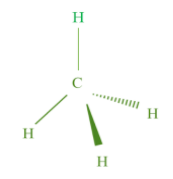Answer
409.8k+ views
Hint: Homologous series of compounds are the series of compounds that have the same general formula but they differ from adjacent members by \[ - C{H_2}\] group and we can determine them by the hydrocarbon chain. Hydrocarbons include alkanes, alkenes, alkynes, etc. Alkanes have carbon atoms attached to other carbon atoms via single bonds.
Complete step-by-step answer:
We know that hydrocarbons such as alkanes, alkenes, and alkynes are a group of compounds which have only two constituents, carbon and hydrogen. In these, the carbon atoms are bonded through single bonds in alkanes, double bonds in alkenes and triple bonds in alkynes.
The homologous group of compounds have the same general formula, such as the general formula of homologous series alkanes is \[{C_n}{H_{2n + 2}}\] where n is the number of carbon atoms in the series. On putting the value of \[n = 1\] , we get its fist member i.e. \[C{H_4}\] (methane). We call them saturated homologous series as they have only single bonds. The structure of methane is

The homologous series of the same functional group and its substituents for hydrogen in a carbon chain and the common difference between a successive member of the family is \[ - C{H_2}\] . So, putting the values of n in the general formula, we can find out any member of that series.
Similarly, we can determine the first member of alkenes from the general formula \[{C_n}{H_{2n}}\] and alkynes from \[{C_n}{H_{2n - 2}}\] .
Hence, the correct option is (D).
Note: In alkanes, the first member has only one carbon atom, but in case of alkene and alkynes, the first member of both have two carbon atoms because they involve double and triple bond respectively which is not possible foe a single carbon. As the molecular mass increases in homologous series, change in physical properties observed as boiling and melting point also increases.
Complete step-by-step answer:
We know that hydrocarbons such as alkanes, alkenes, and alkynes are a group of compounds which have only two constituents, carbon and hydrogen. In these, the carbon atoms are bonded through single bonds in alkanes, double bonds in alkenes and triple bonds in alkynes.
The homologous group of compounds have the same general formula, such as the general formula of homologous series alkanes is \[{C_n}{H_{2n + 2}}\] where n is the number of carbon atoms in the series. On putting the value of \[n = 1\] , we get its fist member i.e. \[C{H_4}\] (methane). We call them saturated homologous series as they have only single bonds. The structure of methane is

The homologous series of the same functional group and its substituents for hydrogen in a carbon chain and the common difference between a successive member of the family is \[ - C{H_2}\] . So, putting the values of n in the general formula, we can find out any member of that series.
Similarly, we can determine the first member of alkenes from the general formula \[{C_n}{H_{2n}}\] and alkynes from \[{C_n}{H_{2n - 2}}\] .
Hence, the correct option is (D).
Note: In alkanes, the first member has only one carbon atom, but in case of alkene and alkynes, the first member of both have two carbon atoms because they involve double and triple bond respectively which is not possible foe a single carbon. As the molecular mass increases in homologous series, change in physical properties observed as boiling and melting point also increases.
Recently Updated Pages
How do you write a chemical formula for the following class 11 chemistry CBSE

How would you write a chemical equation representing class 11 chemistry CBSE

Write a chemical equation for the reaction of 1 Iron class 11 chemistry CBSE

Write a chemical equation for the event Zinc oxide class 11 chemistry CBSE

Write a brief note on hyperconjugation and give all class 11 chemistry CBSE

Write about the most common point defects class 11 chemistry CBSE

Trending doubts
Which are the Top 10 Largest Countries of the World?

Fill the blanks with the suitable prepositions 1 The class 9 english CBSE

Difference Between Plant Cell and Animal Cell

Write a letter to the principal requesting him to grant class 10 english CBSE

What is the full form of AD a After death b Anno domini class 6 social science CBSE

Difference between Prokaryotic cell and Eukaryotic class 11 biology CBSE

Give 10 examples for herbs , shrubs , climbers , creepers

Change the following sentences into negative and interrogative class 10 english CBSE

What is pollution? How many types of pollution? Define it



